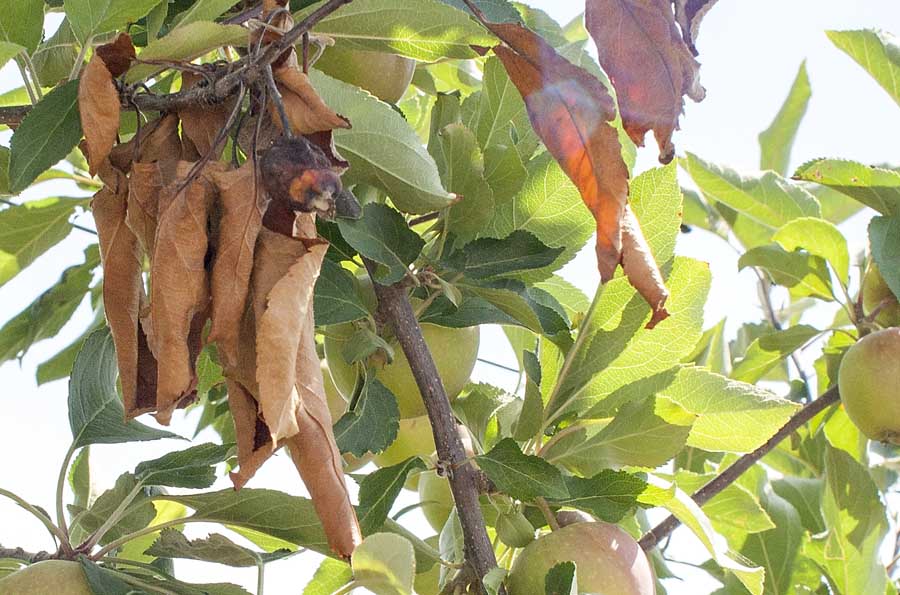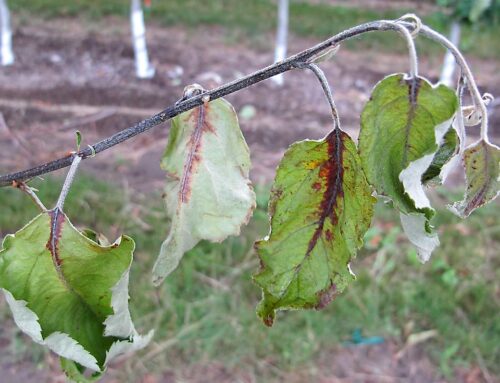
Participants in the International Fruit Tree Association New York Study Tour saw lots of orchards with fire blight in them alongside the roads of Orleans and Monroe counties. (Dave Weinstock/Good Fruit Grower)
A new study by researchers in New York shows that antibiotics remain the tool of choice for fire blight prevention in conventional apple orchards and that Apogee can be used in young blocks without limiting growth.
Fire blight hit Eastern New York growers especially hard this year and never stopped, thanks to a one-two punch of heat and some untimely early summer windstorms in the Lake Champlain and Hudson Valley apple growing regions.

Kerik Cox
“All it takes is a few storms and 30 to 40 bacteria and you’ve got trouble,” said Kerik Cox, Cornell University School of Integrative Plant Science associate professor.
Apple growers use two chemical tools to control fire blight: antibiotics to suppress growth of the bacterial pathogen Erwinia amylovora, in its blossom blight phase and also later in the season, and Apogee (prohexadione calcium) to slow down and toughen tender growth during the shoot blight infection phase.
However, concerns about antibiotic resistance have raised questions about whether they should be used widely, and growers are hesitant to apply Apogee to young trees, even though they are especially susceptible.
Researchers in New York infected four plots in one orchard with fire blight to evaluate best treatments last spring and summer. They then treated the trees with various fire blight control products; some trees were treated after infection with Apogee and a systemic acquired resistance inducer.
“Overall, most of the products did fairly well controlling both blossom and shoot blight,” though the antibiotics showed the strongest effects, said Amelia Zhao, a senior neuroscience major at Hobart and William Smith Colleges in Geneva, New York, who conducted the study with Cox.
In the study, streptomycin, kasugamycin and oxytetracycline topped the list of fire blight control products.
Luckily, antibiotic resistance is not a problem in New York — yet. Nineteen orchards there reported streptomycin-resistant disease in 2012 and 2013, but there have been no reports since.
“There have been no reports of kasugamycin and oxytetracycline of fire blight pathogen resistance in New York,” Cox said.
Zhao presented the findings at the 2016 Cornell Fruit Field Day, attended by Finger Lake region growers and International Fruit Tree Association New York Study Tour participants in mid-July.
Trial setup
Fire blight is a bacterial infection exacerbated by early summer’s heat, which helps the bacteria multiply. It spreads by means of rain, birds and insects (Read “Blight and bugs,” Good Fruit Grower, September 2016).
There were four blocks in the research orchard, providing four replicates for each treatment.

Amelia Zhao
Zhao and Cox applied treatments at pink, 20 percent bloom, 40 percent bloom and 80 percent bloom using a motorized backpack application.
On May 12, the day after the 80 percent bloom application, they used hand pumps to inoculate the orchards with fire blight bacteria.
Control trees, which were untreated, presented 60 percent blossom blight incidence and 23 percent shoot blight incidence.
For the three most effective treatments — streptomycin, kasugamycin and oxytetracycline — incidence of blossom blight was under 10 percent and shoot blight was under 5 percent.
Biocontrol products were less effective at controlling fire blight, reducing blossom blight to 20 percent and shoot blight below 10 percent. But Zhao and Cox enhanced their effectiveness to levels similar to those of antibiotics by adding fungicides to two of them.
Adding Magna-bon CS 2005 (copper sulfate pentahydrate) to Regalia (Reynoutria sachalinensis), a SAR product, almost halved both blossom blight to 10 percent and shoot blight incidence to 3 percent.
Similarly, adding Rampart (mono- and di-potassium salts of phosphorous acid) to Serenade (Bacillus subtilis) cut blossom blight by two-thirds to 3 percent and increased shoot blight incidence slightly to 3 percent.
The next best contender was a program of Apogee and Double Nickel (Bacillus amyloliquefaciens), a biological control product, at full bloom.
Apogee thickens plant cell walls, slowing the invasion of infections occurring later at bloom. Bacteria in Double Nickel produce antimicrobial metabolites to reduce the populations on the stigmatic surface.
Though not as effective at fire blight control as antibiotics, they still kept blossom blight down to less than 30 percent and shoot blight to 5 percent, Zhao said.
Apogee in young blocks
Typically growers are hesitant to use Apogee on younger trees because they don’t want to limit their growth. That’s why Zhao and Cox also tested its use in young stock.
“We wanted to see if they would control blossom and shoot blight without using antibiotics and negatively affecting growth,” Zhao said.
They applied Apogee in both early and late treatments. The early treatment — done at pink — was a combined application of Apogee and Double Nickel. The late treatment, Apogee by itself, was done at petal fall.
They applied Apogee in both low and high concentrations in the early treatment and in high concentration only in the late treatment.
The low concentration treatment was 3 ounces per 100 gallons, while the high concentration treatment was 6 ounces per 100 gallons.
Double Nickel was applied at one rate, 32 fluid ounces per acre.
Early Apogee treatments kept both blossom and shoot blight incidence below 10 percent. Late treatments took blossom shoot incidence down to 12 percent and shoot blight to less than 5 percent.
Apogee, in both low and high concentrations and early and late applications, did not negatively impact fruit size. “All the treatments showed good increases in fruit size,” she said.
Two of the trial products — streptomycin and late Apogee treatments — lived up to grower concerns, stunting primary shoot growth. Overall primary shoot length averaged 98 inches. Streptomycin-treated tree primary shoots reached only 78 inches and late Apogee treatments produced 70-inch primary shoots. •
– by Dave Weinstock






Leave A Comment